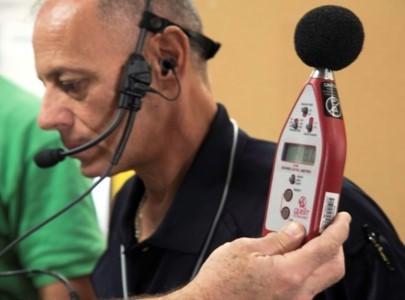
When asked to assist with the evaluation of first responder equipment, Oak Ridge National Laboratory’s Technical Testing and Analysis Center (TTAC) brought in special weapons and tactics (SWAT) team members from across the country to assist in the project—a task that presented unique challenges in preparation and coordination.
TTAC assessed hearing protection with integrated radio communications in its role as a technical agent for the US Department of Homeland Security’s (DHS’s) System Assessment and Validation for Emergency Responders (SAVER) program. SAVER develops objective assessments of commercially available equipment and provides that information to first responders for use in purchasing decisions.
The hearing protection was assessed by six evaluators from various SWAT teams during indoor and outdoor scenarios during the summer of 2016. Team members evaluated the headsets according to how well they could receive and send communication while a siren sounded and during normal and whispered conversations. Testing then moved outdoors to Y-12’s Central Training Facility (CTF), where SWAT team members evaluated the headsets during the use of flash bangs and the firing of a pistol and rifle.
The assessment took place in mid-August 2016, but the prep work began a year earlier. The project was quite different from TTAC’s typical scope, which involves evaluating radiological detection devices in its lab space, noted TTAC project manager Jacqueline Shipwash.
In December 2015, Shipwash facilitated a focus group of evaluators tasked with gathering information for headset requirements and typical scenarios in which the headsets would be used. The evaluators were carefully chosen to ensure a mix of experience—some were trainers, others were ex-military, and their experience as first responders ranged from 5 to 25-plus years, Shipwash noted.
She also performed market research to select the headsets using the criteria gathered at the focus group meeting. The headsets ranged from bone conduction technology to standard ear cups and included controls and boom microphones of various designs and placement.
Because the assessment involved firearms, Shipwash involved CTF personnel, as well as ORNL’s General Counsel, Safety Services, and the Laboratory Shift Superintendent’s office. Part of the approval process also involved coordination with ORNL’s Site Use Planning Committee and the Oak Ridge Site-Wide Institutional Review Board.
The four main categories under assessment were capability, deployability, usability, and maintainability.
To assess capability, criteria such as decibel reduction, radio communications clarity, ambient noise amplification, and battery power were examined. Deployability criteria included the overall ruggedness of the headset; the size and fit of the headset with helmet, eyewear, and gas masks; and even what color options were available.
“I kidded the guys about color, but as it turns out, this is a factor. I learned that black is the worst color for gear as it stands out during most SWAT uses,” Shipwash said.
Usability looked at such factors as comfort level for each individual, whether the equipment stayed in place as the wearer fired a rifle in various positions—standing, kneeling, or prone—and the accessibility of controls and the microphone. And finally, maintainability looked at available technical support and warranty information and at how easy it was to change batteries in the field.
“We appreciate everyone who was involved,” Shipwash said. “Participants were motivated and dedicated, and the work was very enjoyable.”
A final report on the assessment is posted on the DHS SAVER website.


